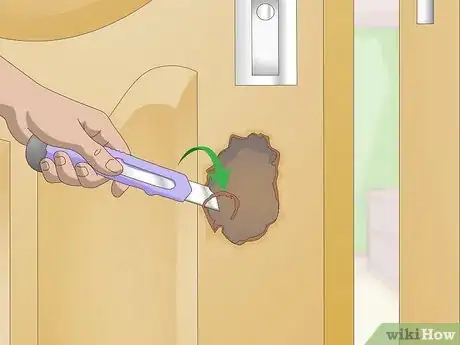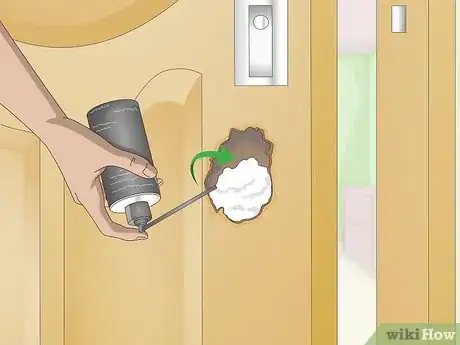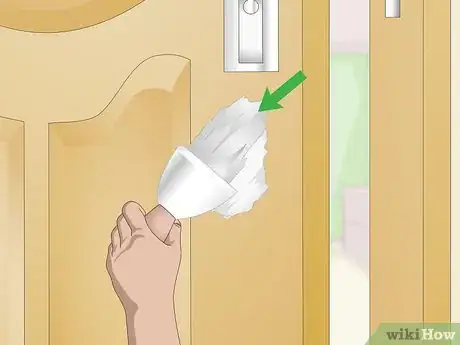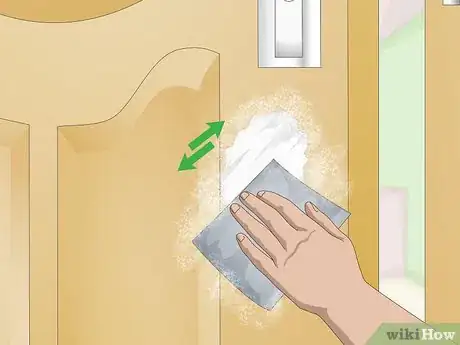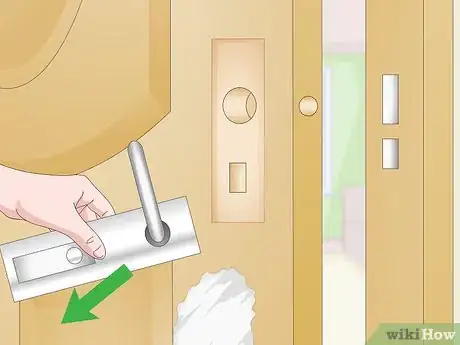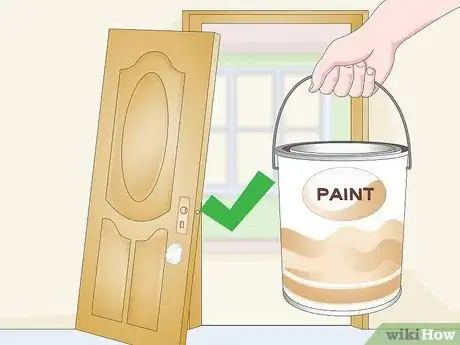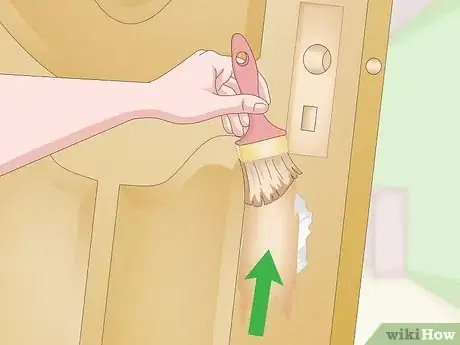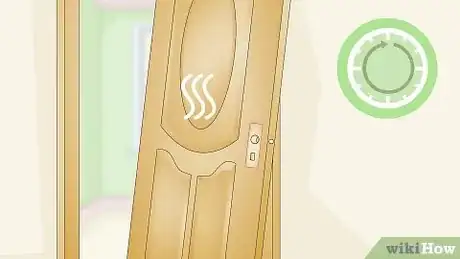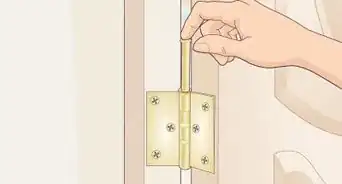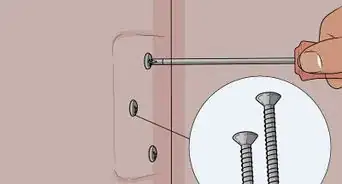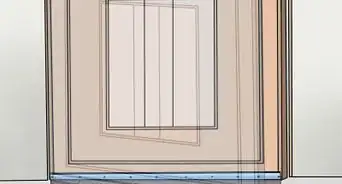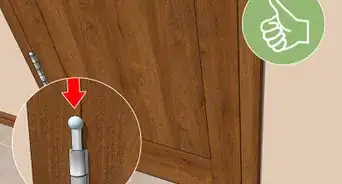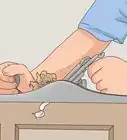This article was co-authored by Barry Zakar and by wikiHow staff writer, Eric McClure. Barry Zakar is a professional handyman and the founder of Little Red Truck Home Services based in the San Francisco Bay Area. With over ten years of experience, Barry specializes in a variety of carpentry projects. He is skilled at constructing decks, railings, fences, gates, and various pieces of furniture. Barry also holds his MBA from John F. Kennedy University.
There are 9 references cited in this article, which can be found at the bottom of the page.
wikiHow marks an article as reader-approved once it receives enough positive feedback. This article received 19 testimonials and 100% of readers who voted found it helpful, earning it our reader-approved status.
This article has been viewed 918,485 times.
Hollow core doors are relatively easy to damage, but they’re even easier to fix. Instead of paying for a brand new door and going through the headache of hanging it, simply patch and refinish the damage! In this article, we’ll break down everything you need to know about getting your door back into tiptop shape.
Things You Should Know
- Fill in the hole or opening with paper towels, cardboard, or wire mesh. Then, fill the opening in with expandable foam.
- Scrape the excess foam off, then use auto-body filler or spackle to patch the damage.
- Once the filler or spackle dries, sand it down. Paint or stain the repair to blend the repair in.
Steps
Patching Holes and Cracks
-
1Cut away any loose or broken wood from around the opening. Depending on how the door was damaged, there may be some loose splinters or fragments around the edges of the hole or crack. Rather than trying to repair these loose pieces, use a utility knife to cut away any damaged wood until you’re left with a clean hole that’s mostly free of rough edges.[1]
- Always cut away from yourself when working with a utility knife, especially when cutting through something sturdy like wood.
- You may need to make the hole or crack slightly bigger before you can begin repairing it. It’s much easier to repair a larger hole free from damaged wood than it is to repair a smaller one that’s fragmented or broken, though!
-
2Pack the hole with paper towels, cardboard, or wire mesh. These materials won’t make the door stronger or repair it, but they’re an easy and affordable way to hold the insulation foam in place while it dries. Bunch up a few paper towels or whatever material you’re using and stuff them in the hole or crack.[2]
- The door isn’t actually 100% hollow. There are a series of diamond-shaped pockets inside the door. If your first bunch of material falls inside the door, keep adding more. You’ll eventually fill the section up.[3]
Advertisement -
3Fill the hole with expanding foam insulation. Expanding insulation foam comes in a spray can with a long nozzle on the top. Point the nozzle inside the hole or crack in your door and begin spraying. The foam will expand to fill the space inside the door, with any excess expanding outside the hole through the face of the door.[4]
- Don’t worry about the foam flowing out of the hole a bit! You’re going to cut the extra off.
- Look for the “low expansion” or “low rise” foam if you want something a little easier to work with.
-
4Leave the insulation foam to dry overnight. Once the insulation foam has filled in the hole or crack, it needs to cure all the way through before it can be cut or sanded down. It may start drying in as little as 30 minutes, but it’ll take 24 hours to completely cure.[5]
- Check the instructions on your own brand of insulation foam for more guidance on how long it will take to dry. Some foams may require longer drying times.
-
5Trim away the excess foam carefully with a utility knife. Position your utility knife slightly above any protruding insulation foam so that it is flush with the face of the door. Gently run the knife down the face of the door to cut away any excess foam. Continue trimming and shaving the foam until you’re flush with the face of the door, or slightly below it.[6]
- If it gets difficult to trim the foam near the face of the door with your utility knife, switch to a razor blade.
- Don’t worry if you remove a little too much foam. You’re going to fill it in.
-
6Apply a layer of auto-body filler for a strong repair. Mix the 2 parts of an auto-body filler together on a sheet of cardboard to activate it. Spread the mixture over the hole in your door with a putty knife. Use the edge of a putty knife to smear and press the mixture over the hole, filling in any gaps to make it flush with the door.[7]
- Auto-body filler is a compound that will give you a very strong door, but it can be quite difficult to work with. It will normally come packaged with a hardening catalyst designed specifically to activate it.
- Some auto-body fillers do not need to be mixed.
-
7Cover the hole with spackle for a quicker fix. If you don't have auto-body filler, you can use spackle (joint compound) instead. Use a putty knife to scoop out some spackle and spread it over the hole in your door. Work in long, smooth strokes to smear the spackle over the door as smoothly and evenly as possible.[8]
- Spackle is readily available, affordable, and very easy to work with. This repair won’t last decades the way auto-body filler will, but this will 100% get the job done.
- If you don’t have spackle or auto-body filler, you can use wood filler instead.
-
8Wait 24 hours for the surface to completely cure. Spackle and auto-body filler compound start to dry relatively quickly, but both materials take a long time to cure completely. Wait at least one day for the filler or compound to become rock solid if you want the best repair possible.[9]
- Check the instructions on your spackle or auto-body filler compound for more information on how long it will take to dry.
-
9Sand down the surface of the repair. Buy a set of sandpaper sheets and start around 100- to 120-grit. Begin sanding down your repair compound. Then, work your way up to 220-grit. Sand off the spackle or auto-body filter until it is level with the surface of the door and it looks flat.[10]
- Repeat this entire process for each hole or crack on the door.
Refinishing the Hollow Core Door
-
1Remove any hardware or hinges if you’re refinishing the entire door. It's best to paint or stain the entire door to achieve an even finish, rather than only painting or staining the area you repaired. Use a screwdriver to remove the hardware from the door. You might need to remove the doorknob, hinges, or a strike plate near the base of the door.[11]
- If you only want to paint or stain the repair, that’s totally fine. It may stand out a bit but if it’s not a commonly used door or it’s in an inconspicuous area, that may not be a big deal.
- If you want to remove the door from its hinges entirely, you can do that as well.
- Alternatively, you could use painter’s tape to tape off areas you don’t want to paint over.
-
2Find paint or wood stain that matches the color of your door. Choosing the right color of paint or wood stain will make sure that the repaired door matches the rest of the doors in your home. Ask an employee at your local hardware store for some paint or wood stain samples or ask for help in choosing the right paint or choosing the right stain to match the color of your door.[12]
- If you can, bring in a sample of the door to help match it—such as a piece of the door you cut away when first repairing it.
-
3Apply an even coat of paint or wood stain to the entire door. Use a broad, all-purpose paintbrush or a foam paint roller to apply a single coat of paint or wood stain to the door. Paint or stain any grooves or panels first, then paint long, even strokes over the rest of the door to avoid leaving visible lines.[13]
- If you’re worried about making a mess, lay down a drop cloth or some old newspaper underneath the door before you begin painting.
-
4Leave the door to dry for 24 hours. Once you’ve applied the first coat, allow the door to dry for 24 hours so that you can see how the color cures into the wood and the repair. Even slight contact with the door can damage the finished look, so make sure everyone who might come in contact with it knows that it is still wet.[14]
- Check the instructions on your chosen paint or stain for more information on the expected time it takes for it to dry.
-
5Apply a second coat of paint or wood stain if necessary and let it dry. Each coat that you apply to the door will darken the color slightly and improve the look overall. Once the first coat has dried, apply a second coat to help obscure any imperfections visible from the first coat. Leave it to dry for another 24 hours before reinstalling the hardware.[15]
- Many interior paints and stains will take several days to cure completely. Be careful with your repaired door for 1 week after painting it to avoid damaging your coat of paint.
- You can apply as many coats of paint or stain as you want, but 2 or 3 coats will normally be plenty to make your door look fantastic.
Expert Q&A
Did you know you can get premium answers for this article?
Unlock premium answers by supporting wikiHow
-
QuestionShould I fix my door or replace it?
 Barry ZakarBarry Zakar is a professional handyman and the founder of Little Red Truck Home Services based in the San Francisco Bay Area. With over ten years of experience, Barry specializes in a variety of carpentry projects. He is skilled at constructing decks, railings, fences, gates, and various pieces of furniture. Barry also holds his MBA from John F. Kennedy University.
Barry ZakarBarry Zakar is a professional handyman and the founder of Little Red Truck Home Services based in the San Francisco Bay Area. With over ten years of experience, Barry specializes in a variety of carpentry projects. He is skilled at constructing decks, railings, fences, gates, and various pieces of furniture. Barry also holds his MBA from John F. Kennedy University.
Handyman
-
QuestionCan you patch a hollow core door?
 Barry ZakarBarry Zakar is a professional handyman and the founder of Little Red Truck Home Services based in the San Francisco Bay Area. With over ten years of experience, Barry specializes in a variety of carpentry projects. He is skilled at constructing decks, railings, fences, gates, and various pieces of furniture. Barry also holds his MBA from John F. Kennedy University.
Barry ZakarBarry Zakar is a professional handyman and the founder of Little Red Truck Home Services based in the San Francisco Bay Area. With over ten years of experience, Barry specializes in a variety of carpentry projects. He is skilled at constructing decks, railings, fences, gates, and various pieces of furniture. Barry also holds his MBA from John F. Kennedy University.
Handyman
Things You’ll Need
- Utility knife
- Paper towels, cardboard, or wire mesh
- Expanding insulation foam
- Auto-body filler or spackle
- Putty knife
- Sandpaper sheets
- Paint or wood stain
- All-purpose paintbrush or paint roller
References
- ↑ https://www.latimes.com/archives/la-xpm-2001-nov-18-re-5499-story.html
- ↑ https://upgradedhome.com/how-to-repair-punch-holes-in-hollow-core-doors/
- ↑ https://www.latimes.com/archives/la-xpm-2001-nov-18-re-5499-story.html
- ↑ https://www.latimes.com/archives/la-xpm-2001-nov-18-re-5499-story.html
- ↑ https://archive.epa.gov/epa/saferchoice/potential-chemical-exposures-spray-polyurethane-foam.html
- ↑ https://homelyville.com/how-to-fix-holes-in-doors/
- ↑ https://www.homeserve.com/en-us/blog/how-to/fix-door-hole/
- ↑ https://www.latimes.com/archives/la-xpm-2001-nov-18-re-5499-story.html
- ↑ https://www.bobvila.com/articles/how-long-does-spackle-take-to-dry/
- ↑ https://www.latimes.com/archives/la-xpm-2001-nov-18-re-5499-story.html
- ↑ https://www.thisoldhouse.com/how-to/how-to-refinish-door
- ↑ https://www.bobvila.com/articles/how-to-match-paint/
- ↑ https://www.homesandgardens.com/interior-design/paint/how-to-paint-a-door
- ↑ https://www.homesandgardens.com/interior-design/paint/how-to-paint-a-door
- ↑ https://www.homesandgardens.com/interior-design/paint/how-to-paint-a-door
About This Article
To repair a damaged hollow core door, start by cutting away any loose or broken wood around the damage using a utility knife. Then, pack the hole or crack with paper towels, and fill it in with expanding foam insulation. Next, let the insulation dry completely before trimming away the excess with a knife. Finally, cover the area with spackle, and let it dry before sanding it down so it's flush with the rest of the door. To learn how to refinish a hollow core door, scroll down!
